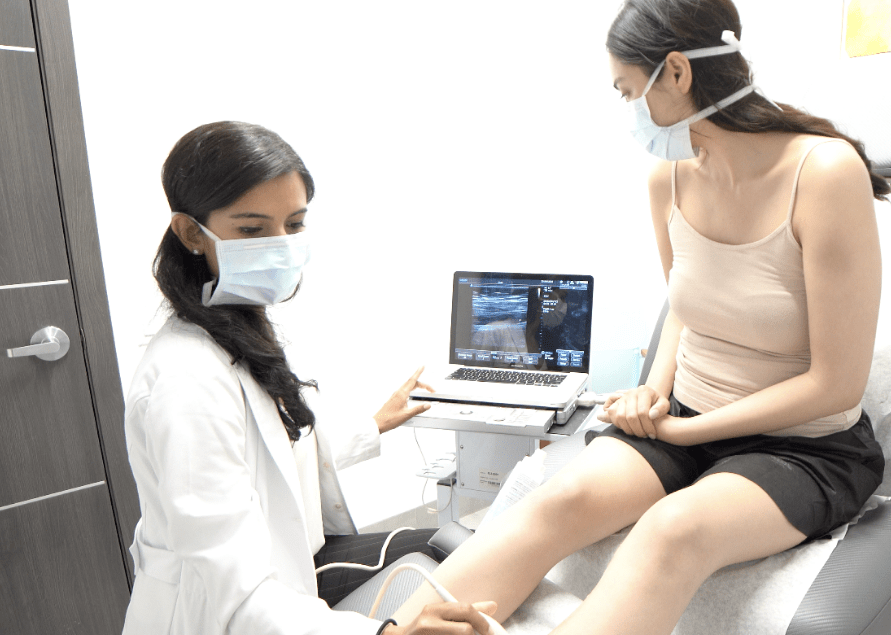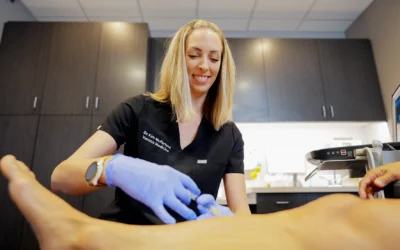Top Maryland Vein Doctors
What Are The Side Effects Of VenaSeal? And Other FAQs
If you’re looking for information about VenaSeal, a medical treatment for varicose veins, you’ve come to the right place! VenaSeal is a minimally invasive procedure that uses a medical adhesive to close the affected veins. It’s an alternative to surgical treatments like vein stripping. But, like any medical procedure, there may be some side effects. That’s why we’ve put together this article to help answer all your VenaSeal-related questions, including the side effects and how it works.
Maryland Vein Treatment is led by board-certified vein doctors who carefully evaluate your leg veins and curate personalized treatment plans to improve your vein health. Our vein doctors offer the latest, minimally invasive varicose vein treatments and ensure minimal side effects. If you’re in the Beltway, please visit our medical center for vein treatment in Bethesda, Maryland. Please schedule an appointment online.
What are the side effects of VenaSeal?
VenaSeal is a minimally invasive procedure that has been found to have a low rate of side effects compared to traditional varicose vein treatments. However, it is still important to be aware of the potential side effects. The most common side effects of VenaSeal include:
- Pain or discomfort at the injection site: This is usually mild and temporary and can be relieved with over-the-counter pain medications.
- Bruising: This is also common and usually resolves on its own within a few days.
- Swelling: Some swelling may occur at the injection site, but this should resolve within a few days.
- Numbness or tingling: This is usually temporary and occurs because of the local anesthetic used during the procedure.
- Infection: This is a rare side effect, but can occur if proper precautions are not taken during the procedure.
It is important to note that the side effects of VenaSeal are typically mild and resolve quickly on their own. However, if you experience any unusual symptoms or side effects, it is important to consult with your vein doctor immediately.
What are the benefits of the VenaSeal procedure for varicose veins?
VenaSeal is a minimally invasive procedure for treating varicose veins that offers several benefits over traditional treatments. These benefits include:
- Minimal Pain– VenaSeal is a minimally invasive procedure that causes minimal pain compared to traditional vein stripping or laser therapy.
- No Scarring– Unlike vein stripping, which requires incisions and can leave scarring, the VenaSeal procedure does not leave any visible scars.
- Faster Recovery Time– VenaSeal patients typically experience a faster recovery time compared to traditional vein treatments. Most patients are able to return to normal activities and work immediately after the procedure.
- No Need for Compression Stockings– Unlike other varicose vein treatments that require the use of compression stockings, VenaSeal patients do not need to wear compression stockings after the procedure.
- High Success Rate– VenaSeal has a high success rate and is effective in treating a wide range of varicose veins.
What are the endovenous laser ablation side effects?
Endovenous laser ablation (EVLA) is a minimally invasive procedure used to treat varicose veins. While the procedure is generally safe and has a low rate of side effects, it is important to be aware of the potential risks and side effects. The most common side effects of EVLA include:
- Pain or discomfort– Some patients may experience mild pain or discomfort at the injection site, but this is typically temporary and can be relieved with over-the-counter pain medications.
- Bruising– Bruising is a common side effect of EVLA and typically resolves on its own within a few days.
- Swelling– Some swelling may occur at the injection site, but this should resolve within a few days.
- Numbness or tingling– This is usually temporary and occurs because of the local anesthetic used during the procedure.
- Infection– While rare, infection can occur if proper precautions are not taken during the procedure.

We know health insurance is confusing so we will help you check if you’re covered:
FREE Coverage Checker:
What are the VNUS closure procedure pros and cons?
The VNUS closure procedure is a minimally invasive treatment for varicose veins that uses a specialized catheter to deliver radiofrequency energy to the affected vein. Like any medical procedure, the VNUS closure procedure has its pros and cons.
Pros of VNUS Closure:
- Minimally Invasive– The VNUS closure procedure is minimally invasive and does not require incisions or scarring.
- Quick Recovery Time– Patients typically experience a faster recovery time compared to traditional vein treatments, with most patients able to return to normal activities within a few days of the procedure.
- No Need for Compression Stockings– Unlike other varicose vein treatments that require the use of compression stockings, VNUS closure patients do not need to wear compression stockings after the procedure.
- High Success Rate– The VNUS closure procedure has a high success rate and is effective in treating a wide range of varicose veins.

Visit Our Maryland Vein Treatment Center
Cons of VNUS Closure:
- Pain or Discomfort– Some patients may experience mild pain or discomfort at the injection site, but this is typically temporary and can be relieved with over-the-counter pain medications.
- Bruising– Bruising is a common side effect of the VNUS closure procedure and typically resolves on its own within a few days.
- Possible Numbness– Some patients may experience temporary numbness or tingling after the procedure, but this typically resolves on its own within a few days.
What are the signs of blood clot after vein ablation?
Vein ablation is a safe and effective procedure for treating varicose veins, but there is a small risk of developing blood clots after the procedure. It is important to be aware of the signs of a blood clot and to seek medical attention if you experience any of the following symptoms:
- Swelling– Swelling in the affected leg is a common sign of a blood clot.
- Pain– Pain or tenderness in the affected area may indicate the presence of a blood clot.
- Redness– A red, warm, or inflamed area on the skin may be a sign of a blood clot.
- Difficulty breathing or chest pain– If you experience difficulty breathing or chest pain, it may be a sign of a pulmonary embolism, which is a serious and potentially life-threatening complication.
- Rapid heart rate– A rapid heart rate may be a sign of a blood clot and should be evaluated by a healthcare professional immediately.



